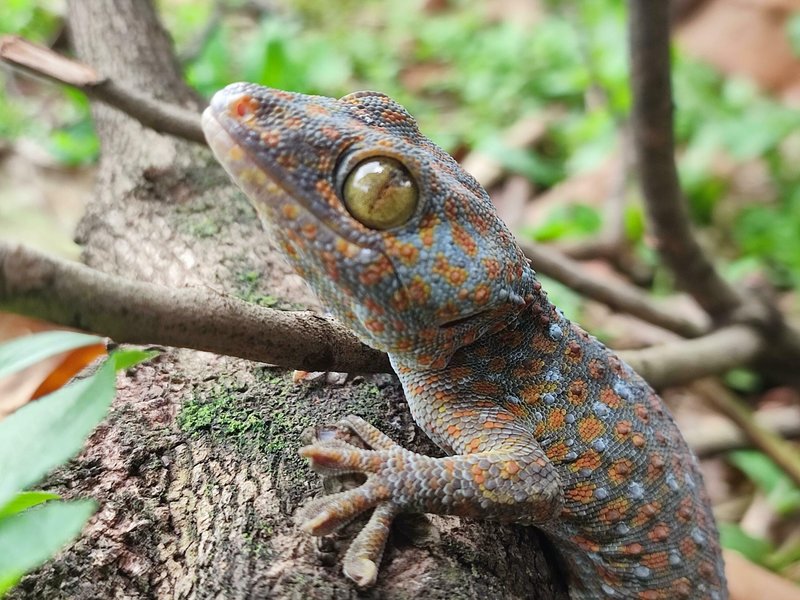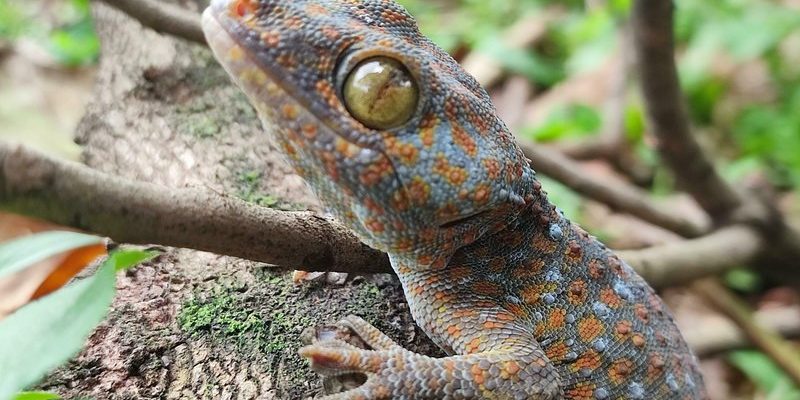
Imagine standing in a tropical paradise, feeling the warm breeze as you scan the surroundings. Geckos can be found in a variety of colors and patterns, each species offering a different clue to its identity. Identifying a gecko isn’t just about spotting it; it’s about observing its traits, behavior, and habitat. So, let’s dive into the colorful world of geckos and learn how to identify these intriguing lizards in their natural environment.
Understanding Gecko Characteristics
When you’re trying to identify a gecko, it’s essential to start by understanding its physical characteristics. Most geckos range in size from a few inches to about a foot long, so size can be a helpful clue. They typically have a squat body, short limbs, and a broad head. One of the most recognizable features of geckos is their flattened toes, which allow them to cling to surfaces—perfect for climbing walls and trees.
Geckos also show a variety of colors and patterns. Some might be bright and vibrant, like the green anole or the blue-tailed skink, while others are more muted. You might encounter geckos that are spotted, striped, or even completely patterned. This diversity allows them to blend in beautifully with their surroundings, making them all the more fascinating to spot.
Another characteristic to note is their tails. Many geckos can shed their tails as a defense mechanism. If you see a gecko with a shorter or missing tail, that could be a sign of its clever survival tactic!
Common Geckos Found in Various Habitats
Geckos are incredibly diverse, and they inhabit various ecosystems worldwide. Depending on where you are, you might encounter different species. For instance, the common house gecko often makes its home near human dwellings, particularly in warmer climates. You’ll recognize it by its pale color and distinctive chirping sounds.
In more tropical areas, you might find the tokay gecko, which is larger and has a beautiful pattern of blue and gray. Its loud calls are hard to miss! If you’re exploring arid regions, look for the desert gecko, known for its sandy color that helps it blend in with the soil.
Learning about these common species can give you a starting point in your gecko identification journey. Each type has its own quirks and behaviors, making the hunt even more enjoyable.
Observing Gecko Behavior
Honestly, observing gecko behavior can be just as revealing as looking at their physical features. For example, many geckos are nocturnal, meaning they become active at night. If you notice a gecko darting around after sunset, you might be looking at a species that thrives when the sun goes down.
During the day, geckos often bask in the sun to regulate their body temperature. If you see one lounging on a rock, that’s a good sign! Pay attention to how they move, too. Some geckos are quick and agile, while others are a bit more sluggish. Their movement patterns can give you clues about their species.
And here’s the thing: geckos communicate. Some “talk” with their bodies, using color changes, while others make sounds, such as clicks or chirps. If you hear a gecko calling, take a moment to listen and observe—it might lead you to the right identification!
Where to Look for Geckos
Now that you know what to look for and how to observe them, let’s chat about where you’re likely to find geckos. Geckos love warm climates, so if you’re in an area with plenty of sunlight, you’re in gecko territory. Look under rocks, inside trees, or even around your backyard!
Here are a few great spots to check:
- Near light sources at night, as insects attract geckos.
- Under leaves and rocks during the day for hiding spots.
- On walls or fences, especially in humid areas.
When searching, be patient. Geckos can be shy, and they often freeze when they sense danger. Give them a moment, and you might be surprised by what comes into view.
Using Tools for Identification
If you’re serious about identifying geckos, consider bringing along a few tools. A good field guide on reptiles can become your best friend. These guides often include images and key characteristics for different gecko species.
You might also find it helpful to have a camera. Taking photos can help you remember details once you’re back home. Additionally, apps that identify wildlife can be a fun way to get real-time feedback on what you’ve spotted. Just snap a pic, and let technology lend a hand!
Don’t forget to keep a notebook handy. Jotting down your observations can help you track patterns, like where you saw certain species or at what time of day. This can be insightful and enrich your overall experience.
Safety Considerations When Observing Geckos
While geckos can be fun and harmless to interact with, it’s still important to keep safety in mind. When in the wild, always respect their space. Avoid handling them unless necessary, and wash your hands afterward. Some geckos might bite if they feel threatened, and it’s always best to appreciate them from a distance.
Additionally, be aware of your surroundings. If you’re exploring in areas with potential hazards, like dense vegetation or rocky terrains, watch your step! Staying safe ensures you can keep enjoying geckos for years to come.
Character Traits: What Makes Geckos Special?
What truly makes geckos stand out is their unique adaptations. Besides their incredible climbing ability, geckos can also regenerate their tails after losing them. This remarkable skill is just one of nature’s cool tricks, allowing them to escape predators.
Many geckos also display color-changing abilities. This isn’t just for camouflage; it can indicate mood or assert dominance. Imagine a miniature chameleon—how neat is that? Their special adaptations make them fascinating creatures that merit respect and appreciation.
Geckos can even help control insect populations around our homes and gardens. So by simply allowing them to roam, we’re benefiting from their natural pest control abilities!
Identifying a gecko in the wild can feel like a mini-adventure, and with these tips, you’re ready to embark on your journey. Remember to observe their physical traits, habits, and the environments they thrive in. Each encounter is a chance to connect with nature and appreciate the little wonders that exist around us.
So, the next time you’re out exploring, keep your eyes peeled and your camera ready. You never know what might scurry by—perhaps a beautiful gecko will make your day! Embrace the experience, enjoy the hunt, and most importantly, have fun discovering the vibrant world of geckos in the wild.

